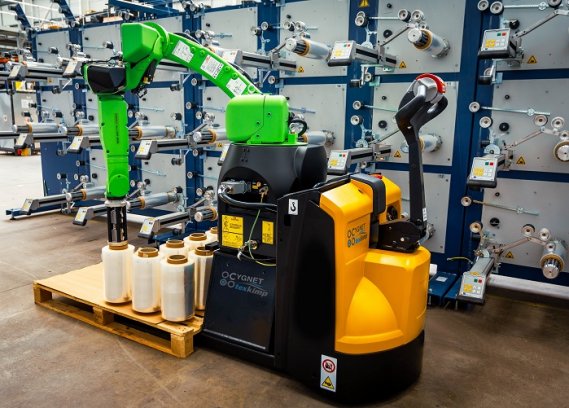andPeteBanham(R)crop-300x192-cropped.jpg)
Cygnet Texkimp announces senior promotions
The UK-based custom manufacturer will unveil the technology at ITMA, where visitors will be able to see the system in action.

6th June 2019
Innovation in Textiles
|
Cheshire
Cygnet Texkimp's new mobile fibre handling system. © Cygnet Texkimp
Fibre handling expert Cygnet Texkimp has developed an AGV-mounted mobile handling system using a collaborative robot capable of lifting packages of fibre weighing up to 35kg. The UK-based custom manufacturer will unveil the technology at ITMA this month, where visitors will be able to see the system in action.
Collaborative robots are designed to work alongside people safely using sensors to detect additional or unexpected loads. The technology first entered the market around five years ago, but until recently was only capable of handling small packages weighing up to 2kg.
“This is a breakthrough solution in terms of addressing the growing trend towards larger bobbins or packages of fibre,” explained Lee Simcock, Director of Technology at Cygnet Texkimp. “Larger bobbins contribute to a more efficient operation because they require fewer changeovers, but they are of course harder for humans to lift and manipulate.”
“The increased payload capacity of collaborative robots combined with advances in AGV technology have enabled us to develop a solution that allows companies to lift and load large packages more easily and safely, including at height. And with no infrastructure needed to navigate around the factory, the technology is completely mobile.”
Cygnet Texkimp’s AGV-mounted robot can be programmed to follow a pre-determined route, which can be changed at low cost according to the task it needs to perform. It can be used for loading and unloading creels, winders, cabling and twisting machines, and shelving and racking structures.
“Collaborative robots work with operators to make the manufacturing process safer, faster, and more productive,” added Mr Simcock. “Conventional robots have to be boxed in for safety because they can’t sense or respond to the presence of a human, but collaborative robots can sense pressure and stop if a person or object is detected, which makes it possible for humans and robots to work alongside each other safely.”
“Collaborative robots are not only strong but also adaptive and easy to programme. They can follow a taught path dictated by the operator rather than requiring software reprogramming, and this allows for rapid and convenient process changes.”

Business intelligence for the fibre, textiles and apparel industries: technologies, innovations, markets, investments, trade policy, sourcing, strategy...
Find out more